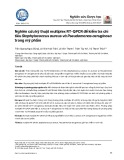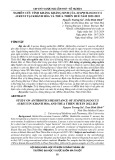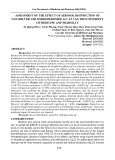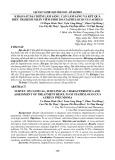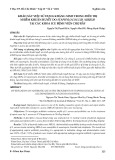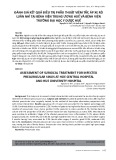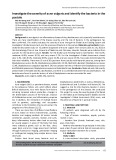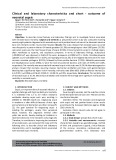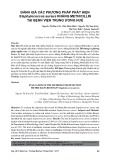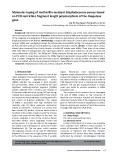
45
Journal of Medicine and Pharmacy, Volume 10, No.7/2020
Molecular typing of methicillin-resistant Staphylococcus aureus based
on PCR restriction fragment length polymorphism of the Coagulase
gene
Ung Thi Thuy, Nguyen Hoang Bach, Le Van An
Department of Microbiology, Hue University of Medicine and Pharmacy, Vietnam
Abstract
Background: Methicillin-resistant Staphylococcus aureus (MRSA) is one of the most predominant agents
that cause nosocomial infections. Objectives: To determine the rate of MRSA and the molecular characteristics
of the coagulase encoding gene of these isolates based on polymerase chain reaction restriction fragment
length polymorphism (PCR-RFLP). Methodology: A total of 100 strains of S. aureus were isolated from clinical
samples. MRSA was investigated through the antimicrobial susceptibility testing. The coa gene was amplified
by PCR and these products were digested by using AluI restriction enzyme. Results: In total, 100 S. aureus
isolates were recovered from clinical samples, of which 59 isolates were MRSA. Three types of coa classes
(550, 700, 750) are distinguished into 6 genotypic patterns, which were coded coa 1-6 and coa 2 was the
most predominant (42.37%). The 700bp and 750bp amplicons formed two (coa 2 and 3) and three (coa 4,
5 and 6) patterns, respectively, whereas the 550bp fragments generated unique patterns designated coa 1.
Only 2 isolates undigested by AluI restriction enzyme. Conclusion: Our results showed that 59% of MRSA
strains are isolated with diverse genotype distributed in many different wards of hospitals by using PCR-RFLP
Keywords: Staphylococcus aureus (S. aureus), coa gene, PCR-RFLP
Corresponding author: Nguyen Hoang Bach, email: nhbach@huemed-univ.edu.vn DOI: 10.34071/jmp.2020.7.7
Received: 17/12/2019, Accepted: 23/12/2020
1. INTRODUCTION
Staphylococcus aureus (S. aureus) is one of the
major pathogens that caused nosocomial infections.
Methicillin-resistant Staphylococcus aureus
(MRSA) infection has emerged in both hospitals
and communities. Today, it is considered the most
significant multidrug-resistant organism [1]MRSA
isolates obtained from a tertiary care hospital in
China were subjected to spa typing, SCCmec typing,
multiple locus sequence typing (MLST. These strains
are resistant to many antibiotics including methicillin
and almost all β-lactam antibiotics. The spread
of MRSA is associated with high morbidity and
mortality rates [2]. Many molecular mechanisms
related to methicillin - resistance in S. aureus have
been studied [3]. Besides, virulence factors allow it
to adhere to the surface, invade or avoid the immune
system and cause harmful effects to the host. The
enzyme coagulase is one of the virulence factors
described earliest, which coagulates human and
animal plasma. It is also the basis of the coagulase
test widely used to distinguish S. aureus from other
Staphylococci [4]. The coa gene, which encodes
the coagulase enzyme, can be used for DNA-based
diagnosis of S. aureus by its high polymorphism due
to the difference in the sequence of the 3′ variable
region. Polymerase chain reaction-restriction
fragment length polymorphism (PCR-RFLP) used to
analyze the coa gene in many Staphylococcus species
has shown diversity in different size and number of
DNA fragments that result in characteristic banding
patterns. The coa gen typing technique is simple,
rapid, and useful to monitor variations in MRSA
populations [5].
The purpose of this research was to investigate
the rate of MRSA isolates at Hue University of
Medicine and Pharmacy Hospital and identify the
molecular characteristics of the coagulase encoding
gene of methicillin-resistant Staphylococcus aureus
based on polymorphic analysis of restriction enzyme
cleavage DNA fragments (PCR-RFLP).
2. MATERIALS AND METHODS
2.1. Study design
This was a cross-sectional study
2.2. Bacterial strains
A total of 100 strains of S. aureus non-duplicate
were collected from different clinical samples in
period of November 2017 to August 2019 at Hue
University of Medicine and Pharmacy Hospital.
Identification of S. aureus from these samples was
performed by standard microbiological methods






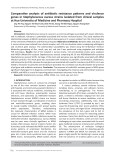
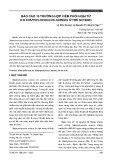
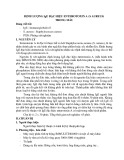


![Tổng hợp và đánh giá hoạt tính kháng khuẩn của các dẫn chất 6-iodophenyl-3h-benzo[e][1,3]oxazine 2,4-dione](https://cdn.tailieu.vn/images/document/thumbnail/2025/20250330/vimitsuki/135x160/9381743339955.jpg)

